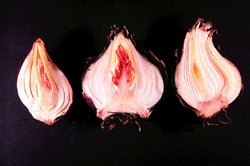|
Ozark Green Thumb BCMG Monthly e-Newsletter |
|
|
 Fall has arrived and it is time to think about spring. Much of the beauty of the spring garden derives from the bulbs gardeners plant in the fall. The word "bulb" is used as a general term by gardeners for any of the flowers planted at this season even though some might be corms (crocus), tubers (anemones) or tuberous roots (ranunculus). But, come spring, the most spectacular flowers are produced by the true bulbs. To the botanist a bulb is an underground storage organ with a vertical stem axis surrounded by swollen leaf bases. The botanical term geophyte is used to describe all the storage types - bulbs, corms, tubers, rhizomes, etc - that gardeners collectively call "bulbs." True bulbs are found only among the monocotyledonous species; those plants with one seed leaf at germination. Most of the true bulbs are found in two plant families - the lily family or the amaryllis family - although many botanists are now breaking these old classification categories into many subsets at the family level. The bulbous habit of growth occurs almost exclusively in temperate parts of the world beyond 30 degrees north and south latitude. The geophytic lifestyle developed as a protection mechanism to allow plants to get through hard times, especially drought and cold. Most bulbous species are native to either grassland habitats or mountainous regions. In grasslands, bulbs are usually spring-blooming, with foliage dying down by early summer when the grasses suck all of the available water from the soil. In mountainous areas the bulbs flower quickly during spring, mature their foliage during the short summer and then disappear below ground during the long, cold winter. Bulbs have all the parts and pieces of an oak tree but they have gotten rid of all the superfluous stuff, leaving behind just a dormant bud. The stem of a bulb grows vertically, just like our oak tree, but it is only a few millimeters long. Called the "basal plate," it has nodes where leaves and new branches are produced and, at the end of the stem, a flower is formed. At the base of the stem, roots form just like a normal oak tree. The accompanying photo shows a cross-sectional view of a tulip, a hyacinth and a daffodil bulb. These species are what we call "tunicate" species, with the leaf bases enclosed in a papery covering. Lilies have "non-tunicate" bulbs, with the individual scales not encased in this protective sheath. Generally the tunicate species show more drought tolerance than the non-tunicate species. The three bulb species shown in the illustration above have three distinct means of maintaining the bulbous lifestyle. The tulip, native to the cold and dry steep regions of Central Asia, replaces its bulb each year after flowering. The food reserves of the original bulb are depleted to produce the stout stem, leaves, and flowers we so admire in April. If the climate is perfect - with cool conditions and just the right amount of moisture - the foliage will persist long enough to regenerate a big healthy bulb for the next season. But when, as in most gardens, conditions are not so good, the big bulb that was planted is replaced with a small bulb, and after two years it is too small to flower. A bulb too small to flower produces just a single leaf that splays out across the ground. Hyacinths, and in fact most other bulbs, retain their bulb from year to year and build on what they started with. If conditions are good the bulb will grow a bit larger; if not so good it will be a bit smaller. But it doesn't start over anew each year, so this lifestyle choice makes these kinds of bulbous plants more dependable repeat bloomers in the garden. Obviously, allowing the foliage to remain as long as possible helps ensure a bigger bulb for the coming season. The daffodil (Narcissus) shown is doing what oak trees do, branching. Some bulbs, like daffodils, branch freely while others, such as hyacinth, are slow to branch. In bulbs this characteristic is referred to as "producing offsets." Because daffodils branch freely it is not uncommon for a clump formed from a single bulb to become so crowded it stops flowering after 5 years or so. Digging, dividing and resetting the bulbs will allow the bulbs to grow large enough to flower. By: Gerald Klingaman, retired
Extension Horticulturist - Ornamentals Extension News - October 23, 2009
0 Comments
Leave a Reply. |
Archives
April 2022
|
|
